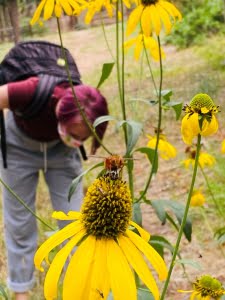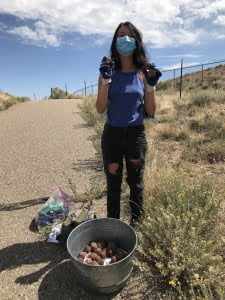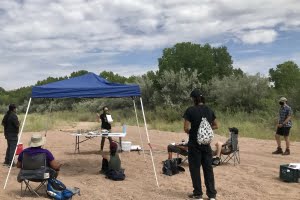
Collaboration and Creativity During COVID-19 Leads to Novel Programming and Meaningful Outcomes for Forest Bound in 2020
by Lia Griesser and Melanie Gisler
Despite the pandemic, our Southwest office in Santa Fe, New Mexico, was fortunate to offer two sessions of our outdoor ecological education program ‘Forest Bound.’ Forest Bound is a free week-long course with lessons geared toward addressing plant blindness, and awareness of career options in conservation and ecological restoration. In 2020, our program was transformed both by a new collaborative session with the Pueblo of Pojoaque and by the need to adapt lessons to safely operate during the COVID-19 pandemic. For both sessions, we got creative and customized games, class sizes, lessons, and ways of interacting outdoors. Carefully structured outdoor classrooms have the opportunity to provide safe student engagement and meaningful hands-on, interactive education that students miss when they are only participating in online classrooms and Zoom workshops. Furthermore, the pandemic has exacerbated the potential for nature deficit disorder (see: Louv, 2005) as people are spending most of their time at home. Forest Bound participants are in good positon to receive immense physical and mental benefits simply from spending significant time outdoors in nature. While we faced many challenges along the way, we have grown our program in ways previously unimaginable.
Session 1 Pueblo of Pojoaque: Forest Bound and Tewa Together
In early July, after the much-needed celebration of the first monsoon rain of the year, the Institute for Applied Ecology’s Southwest office and the Pueblo of Pojoaque’s Tewa Language Department partnered to pilot the first-ever Forest Bound-Tewa Language program. The course was inspired by the inseparable connection between cultural diversity, community stability, and biological diversity as well as the role traditional ecological knowledge can play in ecological restoration.
Tewa is a Native American language spoken by six Puebloan tribes residing along the Rio Grande River and its tributaries in northern New Mexico. Forest Bound programming has historically been geared to middle and high school age students, however, in the spirit of intergenerational learning our course was open to all ages allowing us to reach youth and tribal elders alike. Throughout the session we collaboratively wove together Tewa language and place-based indigenous theory with plant identification, botanical terminology, and ecological restoration practices.
Our home base was the shaded patio at the Poeh Cultural Center, an adobe museum that can be seen glittering from U.S. Highway 84 like a gem that it is thanks to its mica-covered plaster exterior. The buildings house a permanent exhibit on Puebloan history, rotating gallery shows, teaching facilities, and community meeting spaces. Every day we journeyed to a new location around the Pueblo of Pojoaque, or P’osuwaegeh Owingeh as it is known in Tewa, “The Water Drinking Place.” While we hiked along Big Tesuque Canyon Trail’s red dirt path, we heard thunder and hid from the rain under the outstretched arm of a shaggy one seed juniper (Juniperus monosperma). With everyone well under the protection of the tree canopy (masked and at a six-foot distance) Samuel Villarreal Catanach, the director of the Tewa Language Department, taught the introductory techniques of the language learning method “Where Are Your Keys?” This method was created specifically for use in the revitalization of endangered languages and utilizes community interaction through games, movement, sign language and repetition. We can attest to the efficacy of this technique as Lia fell asleep each night to the Tewa phrases for “What is this?” and “This is a ____” repeating in her head.
Standing safely under those big beautiful conifers, we took out piñon seeds to snack on while we explained the evolutionary history of plants as scientists understand it. We talked about the transition from gymnosperms to angiosperms, specifics of reproductive methods by cone as opposed to flower, and other common species interaction with conifers such as lichen, fungus, birds, and beetles. Cris Velarde, fluent Tewa speaker and language instructor, shared traditional uses for the trees like how juniper (often called cedar in northern New Mexico) is used to fire pottery and how Douglas Fir is regarded as superior to Blue Spruce. I pointed out how to look for distinguishing features with each conifer we came across, while Samuel and Cris introduced them with their Tewa names.
On Wednesday we traveled to Pojoaque Creek to learn measuring and monitoring techniques and look at riparian plants with IAE’s Southwest Director, Melanie Gisler. We talked about how native plants can be pushed out by introduced plants with powerful defenses and adaptations not meant for our fragile high-desert ecosystem, how we can work to bring back native plant diversity, and the brilliance of many indigenous land management practices that have increased biodiversity for centuries. Afterwards we harvested seed from native plants Indian ricegrass (Achnatherum hymenoides), hairy false golden aster (Heterotheca villosa), and purple three awn (Aristida purpurea) with Maria Mullins, IAE’s Southwest Seed Partnership Coordinator. Maria showed samples of pressed plants from IAE’s herbarium and seeds from our catalogue, taught how to tell when seed is ready to collect, and let students experiment with methods for cleaning seed. This launched a discussion about knowledge keeping traditions of oral cultures with the help of writing by Tewa Elder Tito Naranjo. Instead of collecting plant materials to preserve, plants were engaged with intimately and consistently through every season. Collection and preservation practices are alive in the experience of elders, and knowledge is transmitted through social roles, language, and the making of daily life. Samuel expressed, however, that some practices related to plant knowledge have been heavily eroded due to colonization and how important it is to restore these systems of knowledge, especially now, with the change in climate taking place. We ended our day getting elbow deep in mud to make seed balls with collected seed for use in our restoration project later that week.
For our lessons on soils, we caravanned to a mostly dry wash where yerba mansa (Anemopsis californica) threw its rhizomatic roots out of the steep sided banks and the Pojoaque River slithers through the parched sands of the arroyo. Ohkay Owingeh elder and beloved University of New Mexico pottery professor, Clarence Cruz, rolled in and out of Tewa and English to more fully communicate stories that illuminated his reverence for clay. He spoke of clay’s ability to connect us all with our ancestors and why natural resources are to be respected. “In Tewa my people say ‘She walks away’ when there is erosion. Erosion is what happens when you disrespect the ground,” said Clarence. Gabriella Coughlin, Tohono O’odham USDA Soil Conservationist, followed with a deep dive into geologic maps, soil horizons, and clay sampling. She shared her story as an activist, organizer, and indigenous woman in the sciences, and how she tries to transition farmers to implement practices that will sustain their soil’s health in the long run.
These and other meaningful educational experiences throughout the week left us eagerly anticipating further collaborative development of this program and possible extension to other Tewa speaking Pueblos. It also brought greater depth, and place-based understanding to our botany and ecology lessons, which we infused into our next session in the Santa Fe Forest.
Session 2 Santa Fe National Forest: Planting the Seeds for Budding Naturalists
While much of the same educational material from past year’s sessions was included in the 2020 Santa Fe Forest session, this course was radically adapted for the pandemic. In typical years, educators provide a brief safety introduction on the first day of a new Forest Bound session. However, this year safety was a part of the conversation and activities several times per day, every day.

First, we tried to establish a mindset that increased student’s awareness of themselves and others around them in the outdoor classroom environment. For one of our first lessons, we hiked to a misty waterfall with moss-covered rocks nestled in the forest. There each participant searched for a plant of their choice to sit with for many minutes, and they drew and recorded every observation possible- considering texture, color, smell, shape and form. This simple exercise revealed how much more you can see by slowing down and staying present in nature. We discussed ways the same can be true of our safety measures. Slowing down not only makes us more aware of where we are in proximity to our friends but also gives us a chance to check-in in with how we are feeling, both physically and mentally. We further borrowed inspiration from a video by renowned potter Maria Martinez from the San Ildefonso Pueblo (P'ohwhóge Owingeh) who spoke of the ways Pueblo peoples ask for permission before taking from nature, and the responsibility they hold for what’s taken. Sharing and practicing this mindset was very helpful in cultivating greater respect for living organisms we interacted with during our lessons and reducing any harm to them. This carried over to helping the students think about harm reduction when interacting with peers.
Social distancing is a challenge for all of us, especially teens that have been cooped-up for months. We knew we would need to get creative to make social distancing reminders fun and to avoid nagging. Educators spent several hours coming up with new games to uphold a six-foot distance. On the first day, each student received a strong 6’ willow branch to turn into a walking stick that they could personalize through carving, painting, and adornments. Tecumseh Collins, 15, whittled away the bark and engraved his with designs while Morgan Taylor, 13, colored hers purple and hung a decorative, magical-looking vial from the top.

Their personalized walking sticks were used on daily hikes and in a variety of new games throughout the session. One game, we called “Rooted in Place,” reflected on the fact that unlike animals, plants are rooted in place and lack the ability to move toward the resources they need (i.e., nutrients, water). Participants stood at least 6’ apart and could not move, like a plant, and used their sticks to pass objects to each other that were scattered on the ground. In another game, students were either pollinators (with a bee at the end of their stick) or flowers (with a flower at the end of their stick). Also attached to the end of all sticks was a spoon. They had to scoop up and pass pollen (fruit gummies) from bee to flower and so on. A great deal of pollen was lost, which probably also happens in nature, but we now have some ideas of how to improve these games for future sessions.
Other games we developed that reinforced distance included a pinecone toss competition (where they also had to identify the tree the pinecone came from), an exercise that demonstrated the extent of the dripline of a ponderosa pine, and the incorporation of rope to illustrate food webs (and appropriate spacing between individuals).
In addition to all of these special adaptations, we followed all of the Center for Disease Control and the New Mexico Association of Environmental Educators guidelines that included limited the number of students to only five, wearing masks, not sharing food (individual snacks provided), parent drop-off to teaching sites in the forest (instead of transporting all students together in a van), and disinfecting/washing hands and equipment after each use. Remarkably, the adaptations we needed to make actually pushed us to grow a better program for the future. Our young participants visibly changed over the course of the week in their connection to each other and enthusiasm for the plants around them. They expressed that now more than ever they were grateful for the chance to be outside, and so were we!
 Acknowledgements: We are grateful to the Forest Service Southwest Region 3 for funding this program, the Pueblo of Pojoaque for co-developing the Forest Bound-Tewa session and for hosting classes, our assistant educator Jessica Zhong who joined the program this summer as an intern from the University of Chicago, and all of the wonderful mentors who enriched this program immensely.
Acknowledgements: We are grateful to the Forest Service Southwest Region 3 for funding this program, the Pueblo of Pojoaque for co-developing the Forest Bound-Tewa session and for hosting classes, our assistant educator Jessica Zhong who joined the program this summer as an intern from the University of Chicago, and all of the wonderful mentors who enriched this program immensely.
Pictured at right, students were grateful to be outside! Wearing masks, they safely enjoy cool weather and subalpine meadows near the peak of the Santa Fe National Forest.
Tags:
Restoration
Research
Education
Contact
Main Office:
4950 SW Hout Street
Corvallis, OR 97333-9598
541-753-3099
info@appliedeco.org
Southwest Office:
1202 Parkway Dr. Suite B
Santa Fe, NM 87507
(505) 490-4910
swprogram@appliedeco.org
© 2025 Institute for Applied Ecology | Privacy Policy



